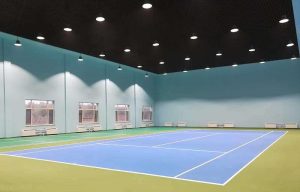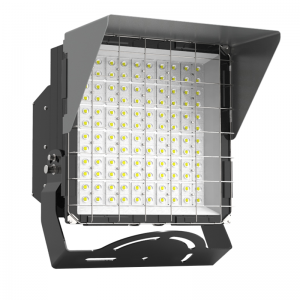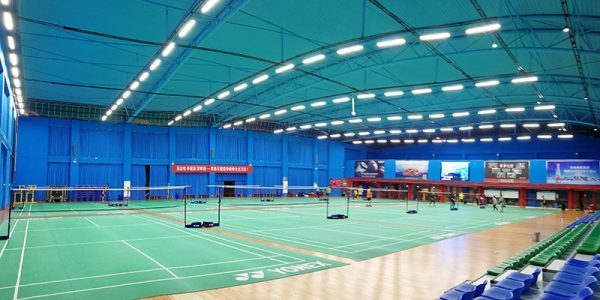International Standard for Badminton Hall Lighting
If you want to know where the professionalism of the badminton hall special light is reflected, you need to understand what kind of requirements the badminton hall has for lighting. In fact, the badminton hall lighting has an international uniform industry standard, which has clear designs for indicators such as “color rendering index”, “glare index”, “horizontal average illuminance”, “vertical average illuminance”, and “light source color temperature”. Standards and testing standards.
“JGJ153-2016 Stadium Lighting Design and Testing Standards Attached Provisions” has made basic regulations, dividing sports lighting into 6 levels: Ⅰ (fitness, amateur training), Ⅱ (amateur competition, professional training), Ⅲ (professional competition) ), Ⅳ (TV broadcasts national and international competitions), V (TV broadcasts major national and international competitions), Ⅵ (HDTV broadcasts major national and major international competitions), among which grades Ⅳ, V, and Ⅵ are mainly for Meet the needs of TV broadcast.
Badminton hall lighting requirements
In the illuminance requirements of badminton hall lighting, the higher the lighting level, the higher the requirements for horizontal illuminance and lighting uniformity. In the “fitness/amateur training” level, the horizontal illuminance is required to reach 300 lux, and the uniformity of lighting is measured by U2, which is the ratio of the minimum illuminance to the average illuminance. This value needs to reach 0.5. For the remaining 5 levels, the uniformity needs to be measured by U1, which refers to the ratio of the minimum illuminance to the maximum illuminance.
The higher the lighting level of the badminton hall, the larger the U1. The ideal ratio is 1. When U1 is equal to 1, the illuminance of every point on the badminton court is the same, but the current technology is more difficult to achieve. VI (HDTV broadcasts major national games , Major international competitions) The requirements are U1=0.7 and U2=0.8. At this time, the naked eye basically cannot see where the badminton court is brighter or darker.
Among the three levels that need to be broadcast, the main reference for the average illuminance is the camera, which needs to be measured by Evmai and Evaux. Evmai refers to the vertical direction of the main camera, and Evaux refers to the vertical illuminance of the auxiliary camera. According to statistics, there are 8 items that need to be tested in terms of illuminance for IV, V, and VI.
The Tachyon badminton hall special lamp can be matched with 150 light distribution curves to make the light more controllable. The lighting of the adjacent lamps is better matched. The actual lighting effect and the computer simulation are smaller, the illumination is more uniform, and the utilization rate is higher. Tachyon badminton court special lamps can output 50,000 hours of constant illuminance, ensuring constant illuminance level and uniformity in the venue, avoiding the increase in the demand and cost of lighting equipment due to the attenuation of illuminance, and reducing the need for lighting equipment to use electricity. Save 40% of energy consumption.
Requirements for glare index of badminton hall lighting
In the fitness/amateur training level of badminton hall lighting, the glare index is required to be less than 35, and the glare index of the other five levels is less than 30. If the glare value is too high, it will have glare effects in multiple positions and different angles of the badminton court. Athletes will feel dazzling and cause interference, which is harmful to the body and mind in the long run.
Tachyon special lighting for badminton hall has high efficiency and soft light. The soft light is more in line with the human body’s visual perception and helps visual judgment. This brings convenience to the design and construction of the badminton court lighting scheme, and can easily make the glare index of the badminton court lighting less than 30.
Color temperature requirements for special lights for badminton halls
In the “HDTV broadcast of major national competitions/major international competitions” level of badminton hall lighting, the color temperature is required to be around 5500K, and for the other five levels, the color temperature is required to be around 4000K. The light emitted by a light source with a color temperature below 3500K is called Warm White, and the light emitted by a light source between 3500K and 5500K is called Natural White, and a light source above 5500K is emitted The light is called Cool White (Cool White).
The light color of the sun during the day also changes with time: 40 minutes after sunrise, the light color is more yellow, with a color temperature of 3000K; the sun is white at noon, rising to 4800-5,800K, and it is about 6,500K at noon on a cloudy day; the light color is reddish before sunset , The color temperature drops to 2200K for paper. The color temperature of candle light is 2000k. The color temperature of the special lamp for Tachyon badminton hall can be customized between 4000K and 5000K.
The color rendering index of special lights for badminton halls
In the lighting of badminton halls, different levels of lighting such as fitness/amateur training, amateur competition/professional training, professional competitions, etc., do not require TV broadcast, so the color rendering index of the light source is not so high, only the color rendering index Ra value More than 65 is fine.
TV broadcasts national matches/international matches, and TV broadcasts major national matches/major international matches. These two badminton hall lighting levels require TV broadcast. In order to ensure the vivid color of the TV broadcast picture, the requirements for color rendering index are also much higher. The Ra value is required to be greater than 80, and the requirements for the “HDTV broadcast of major national competitions/major international competitions” are higher, and the Ra value is required to be greater than 90. The color rendering index of the special lamp for Tachyon badminton hall is greater than 90, which can meet the lighting requirements of all levels of badminton halls.
Lighting design scheme of indoor badminton court
1. Badminton court standard
The badminton court is a rectangular field 13.40 meters long, 5.18 meters wide for singles and 6.1 meters wide for doubles. The diagonal length of the doubles court is 14.723 meters, and the diagonal length of the singles court is 14.366 meters. The center of the court is divided equally by the net (both pillars are 1.55 meters high and the middle net is 1.524 meters high).
The badminton court is divided into the left and right halves by the center line horizontally, and the frontcourt, midfield and backcourt are divided longitudinally. The front field is the field from the front line to the net, the back field refers to the field from the end line to the post-doubles line, and the midfield is the field between the front line and the post-doubles line.
According to international competition rules, the minimum space above the stadium is 9 meters. In this space, there are no other beams and obstacles, and no obstacles within 2 meters of the stadium. There should be at least 2 meters between any two courts side by side.
2. Features of badminton court lighting
The lighting of badminton courts usually adopts three forms: natural lighting, artificial lighting and mixed lighting using both at the same time. Most modern badminton halls use mixed lighting, and the artificial lighting of badminton courts is general lighting.
In the design of the badminton hall, in order to enable players to accurately judge the course, height and drop point, the first is to maximize the use of natural light. The effect of natural light is the best. Of course, it is necessary to prevent glare. Reflected into the eyes. The second is to increase the stability of the illuminance and the uniformity and coordination of the distribution. This is not only for the athletes to achieve excellent results, but also for the referee’s accurate judgment and audience appreciation are very important.
3. Influencing factors of badminton court lighting quality
1) Illumination level: Whether the illuminance meets the standard
Generally speaking, the vertical illuminance should be greater than 1/2 of the horizontal illuminance.
When the vertical illuminance is equal to the horizontal illuminance, the sports environment is the most ideal.
2) Illumination uniformity: whether the illumination of the sports field is uniform
The uniformity of illuminance is used to measure the visual conditions in the stadium. Uniformity means
that the stadium should be able to be evenly illuminated, and there should be no areas that are too bright or
too dark, so as to provide a good visual environment for athletes, referees and spectators. For example,
for television broadcasting, when the camera shoots the panorama of the competition area, the illuminance
cannot change greatly, otherwise the camera will be exposed.
3) Glare: Whether the glare is obvious.
Glare is another important factor in evaluating the quality of lighting. Glare is related to the installation height
of lamps, installation methods, number of lamps, installation density and light distribution of lamps.
When there is an excessively high brightness contrast in the field of view, people will feel glare, thereby
affecting people’s vision. If you look at the sun at noon on a sunny day, you will feel that you cannot open
your eyes. This is the glare caused by the high brightness.
The glare of the badminton court is direct glare. Due to the low ceiling, the light source is very dazzling
when the personnel are moving. Over time, the eyes will be uncomfortable, which seriously affects the
athlete’s observation of the movement of the ball.
4) Brightness ratio: the color and brightness difference between the object and the background.
The eyes can distinguish the object on the background, it needs to meet one of two conditions, that is, the background and the object have different colors, or the background and the object have a certain brightness
contrast. If the object is brighter and the background is slightly darker, the vision will be good. On the contrary,
if the background is brighter than the object, the vision will be significantly reduced. When the lighting conditions are poor, it may cause false visual phenomena, distort the perceived object, and have a bad influence on judging important information.
The color of badminton is white. If the background wall is white, it will cause players to lose sight of the course.
In order to increase the color difference between the shuttlecock and the background wall, the light and shadow effect of the lamp is used to reduce the brightness of the background wall. The optical fiber can be blocked by an opaque lampshade, and the shadow of the lampshade can be projected on the wall, while another part of the light
is projected on the ground and reflected into the field, thereby reducing the brightness of the background wall, making the contrast between the badminton and the background wall very different, thus making the athletes feel better. The vision is clearer.
5) Stability of lighting: Whether there is stroboscopic.
The stability of lighting directly affects people’s visual health. Unstable lighting can lead to reduced vision for athletes. The lighting stability is mainly reflected in the stroboscopic effect. The stroboscopic is caused by the periodic change of the current when the AC power is supplied. At the same time, the luminous flux will also
change periodically, which makes people look at the object and cause an illusion. The periodic change of current causes the light source to be unstable, which causes obvious flicker during artificial lighting. When observing the trajectory of the shuttlecock, you can see a relatively fuzzy shadow with low resolution.


